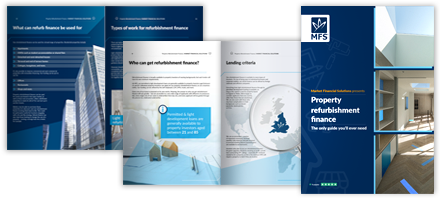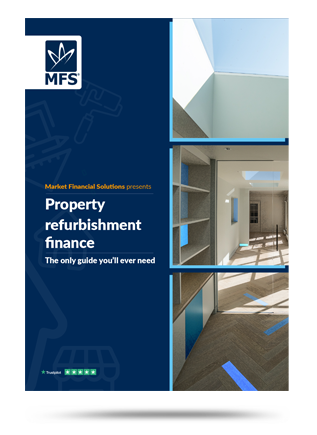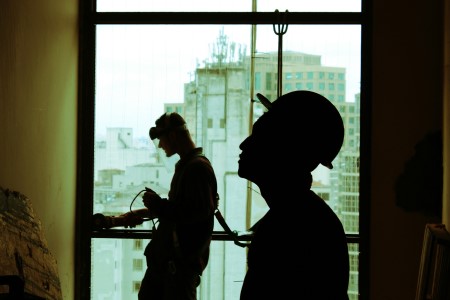
Written by Liza Campion
Head of National Accounts
Market Financial Solutions are a bridging loan and buy-to-let mortgage provider and are not legal, financial, investment or tax advisers. This document is for informational purposes only and does not, and should not be considered, to constitute legal, financial, investment or tax advice or be relied upon by any person to make a legal, financial, investment or tax decision. Therefore, Investors are encouraged to seek appropriate professional advice. The information in this content is correct at time of writing.

The last few years have forced homeowners and property investors to really focus on their assets, and reevaluate their plans. Starting with the pandemic, the stamp duty holiday led to an explosion in the market, while homeowners across the country re-examined their homes as they ended up stuck inside. The UK property market saw unprecedented levels of demand as the rest of the economy shut down.
A record 213,120 transactions took place in June 2021[1] – before the taping off of the stamp duty perks. This became the largest number of transactions per month since October 1988.
Refurbishment work also rose during the same period. In May 2021, the Planning Portal in England & Wales received 63,497 applications, a 52% increase when compared to May 2020[2].
In the current market, the looming Renters Rights Bill, Awaab’s Law, and hiked EPC targets will end up forcing property investors to focus on upgrading their assets. But, how exactly does one define refurbishment vs renovation? What impact does it have on a property, and how much is it likely to cost? We’ll explore these questions and more in this blog.
Definition of Refurbishment
The refurbishing of a property is broadly defined as the actions made to improve or upgrade a property, with common examples being installing new bathrooms, kitchens, or general redecoration. Refurbishment tends to increase the overall value and quality of a property.
Refurbishment vs Renovation vs Refurnishing: What’s the Difference?
From the get-go, investors will want to make sure they’re aware of the differences between the three terms. Some may run the risk of thinking the words are interchangeable and basically mean the same thing.
While refurbishment is generally concerned with increasing a property’s value or prospects, renovation refers to restoring something to a good working condition. For example, an old building with a decrepit roof will need renovating. Whereas installing new sinks in a bathroom will typically be a refurbishment.
Additionally, refurbishment tends to involve the rebuilding or upgrading of assets with new (hopefully better) materials. Whereas refurnishing involves getting entirely new furniture to replace what came before.
What types of assets can be refurbished?
While the definition of refurbishment vs renovation may seem obvious, it can encompass several elements not initially thought of. Most are likely to think of aesthetic changes when they hear the word refurbishment. But the act can also include structural changes. Upgrades made to the wiring, plumbing or ventilation of a property can fall under the refurbishing umbrella.
Having a clear understanding of the type of work that’s needed will help clarify plans. Knowing exactly what specific elements of a property are being upgraded will narrow down what workers are needed, or define the refurbishment budget required.
Bathroom
Tenants can be easily put off by an out-dated bathroom. It’s a place where tenants want to feel their most relaxed. The look and feel of the room plays into this feeling. Older bathrooms can also give the appearance of being unclean. Bathroom tiles and paint may begin to crack, and marks may appear on the walls.
Elements such as the bath and taps can begin to gather rust, grime or build up limescale should the water in the area be hard. Refurbishing a bathroom will not only add a sense of modernity to the property but it also has the potential to increase a property value by 4-5%, according to Resi[3].
Kitchen
The kitchen is the heart of the home, so it’s important to ensure it’s looking its best. Whilst annual wear-and-tear may not take on an immediate effect in the kitchen area, when the time does come, it can be a very costly update. Particularly when it comes to white goods.
It’s important to ensure all the white goods are up to standard and assets like the oven have been professional cleaned. Those are elements that tenants are likely to notice, especially if they’re paying a more premium price. Installing a dishwasher can also increase your rental charge, as it is often an added benefit for the tenant(s). Quality counter tops, particularly those in a darker colour such as granite, won’t mark as easily. This reduces its maintenance needs.
A new kitchen can add around 6-8% to a home’s value, according to Check a Trade[4].

Living Room
If a landlord is letting their BTL with furnishings included, items in the living room are likely to receive the most wear-and-tear. This is the room that tenants spend most of their time. Regular maintenance from the landlord will most likely be needed. So, it’s worth considering this when it comes to purchasing items for this area of the property. A defined refurbishment budget here comes in handy.
With an increase in working from home, landlords could look at adding workable surfaces for their tenants, such as installing a larger dining table or adding a desk. Carpets flatten, and underlay will need to be replaced. Replacing carpet with wooden floors is likely to see less damage and last longer. Real wooden floors may also increase a property’s overall value.
When it comes to HMOs, landlords may want to add a communal area that all their tenants can relax in. The larger this space, the better. If one looks to convert a property into an open plan style to maintain the feeling of spaciousness, why not check out our conversion bridge loan.
Bedrooms
Having space to freely walk around the bedroom without banging one’s legs against the edge of the bedframe is a tenant’s dream come true. Keeping this room unchipped, fresh-faced and mark-free will be the challenge, as it is used daily.
If tight on space in the living room, desks may be best located in bedrooms. Properties with multiple rooms could see the introduction of an office space. This can pique the interest of many tenants, particularly as flexible working has become relatively normalised since the pandemic.
Installing a built-in wardrobe can attract potential tenants to a property as they often offer create more storage space. Property investors are likely to see an increased return from this if they’re looking to sell a property in the long run; if performed to a quality standard.
What Are the Advantages of Refurbishment?
Refurbishment can increase the value of a property, potentially allowing investors to sell on their purchases for a profit. This will be affected by a number of variables. however. And investors will need to make sure they factor in the costs of the refurb.
Refurbishment can also create opportunity for buy-to-let investors. Renters may be willing to pay a bit more to live in a home which has been upgraded. This doesn’t necessarily need to involve what’s pleasing to the eye either.
By 2030, all rental properties will need to hit a minimum energy efficiency rating of C under current plans[5]. Millions of rental properties will need to be upgraded to hit this target[6], which will cost landlords. But, making these upgrades may prove to be worthwhile, given that the most energy-efficient buildings achieve the highest rents, even after controlling for variables such as building age and location, according to Savills[7].
How Does the Refurbishment Process Work?
While defining refurbishment vs renovation is straightforward, understanding the process from start to finish can be tricky. There is a lot of variation in how refurbishment works are done, and no two cases will be the same.
The requirements for a new paintjob will be completely different to installing upgraded plumbing. At the very initial stages, investors will need to plan out what refurbishment they’re after. They’ll need to ask themselves if they’re planning an extension, knocking down existing walls, or adding additional doors etc.
A lot of refurbishment work will need planning permission[8], which should be sought from a local council. Each local authority will differ, but they should be able to clearly tell enquirers if permission is needed and if it is, they’ll point them in the right direction.
Where substantial plans are in the works, such as loft conversions, building control services will be needed[9]. These services are provided by local authorities across England and Wales, ensuring building regulations are complied with during the project(s). They will ensure any changes made are structurally sound and safe from the risks of fire etc.
Once all the planning is clearly laid out and all the compliance boxes are ticked, investors will need to go out and find builders or contractors who can do the work. A good place to start would be to get recommendations and referrals from reliable associates. However, there are several resources online for those who are not sure where to start, such as checkatrade.com.
When the work is ready to get started, a contract should be written up. This may help keep the ongoing work stick to defined refurbishment plan and timeframe. In an ideal world, building work would finish ahead of schedule without any hiccups and come underbudget. But, making upgrades to a building – one which may be 100s of years old – can be notoriously difficult. Property investors will need to be prepared for unexpected problems and unforeseen costs.
What Are the Defined Costs of Refurbishment?
Given the variation involved, it can be difficult to define the average costs of refurbishment for investors. For 2025, a full kitchen renovation cost can vary considerably from £6,200 to £50,000[10]. Meanwhile, on average, laminate flooring installation costs around £60 per m² (inclusive of materials and labour[11]). Evidently, fully planning out a project and negotiating with contractors is crucial.
Investors will also need to keep an eye on their taxes. Refurbishment as well as renovation can increase value, but this may result in higher tax bills too. Capital gains tax may be due on properties sold for a higher value than what they were bought for. Additionally, if rents are raised after an upgrade, income tax costs could also jump.
There are a number of allowances and tax deductibles available to those who invest in upgrading a property. As such, investors will likely want to seek out guidance from tax experts or accountants ahead of time.
How to Finance Your Refurbishment?
When taking on a defined refurbishment project, it is important to understand one’s financial options. Specialist lending can help complete renovations in a timely manner, as funds can be issued within mere days. The challenge is finding a lender with a proven track record of financing renovations, refurbishments, and conversions.
Alternative finance such as bridging loans can provide the breathing space to buy, refurbish and refinance or re-sell the investment asset at a higher value. Property investors can also raise finance for the works through a second charge bridging loan. Read more about second charge lending on our product page here.
We’re experienced in refurbishment loans. We work alongside the property owner and/or their broker to meet their deadline and ensure the project is completed on time. For more information about our specialist finance products, get in touch with a member of our team.
The Complete Guide to
Refurbishment Finance
Everything you need to know
- Basics of refurbishment
- Different finance types
- Lending criteria & calculator
- Real life case studies
[1] https://www.savills.co.uk/research_articles/229130/317325-0
[2] https://www.theplanner.co.uk/2021/06/14/52-year-year-increase-planning-applications
[3] https://www.more-bathrooms.co.uk/help-advice/2024/06/how-much-value-does-a-bathroom-renovation-add#:~:text=According%20to%20Resi%20a%20bathroom,new%20bathroom%20isn’t%20worthwhile.
[4] https://www.checkatrade.com/blog/cost-guides/renovate-kitchen-cost/
[5] https://www.property118.com/governments-epc-targets-for-landlords-are-unrealistic-nrla/
[6] https://www.propertynotify.co.uk/news/epc-ratings-what-landlords-need-to-know/#:~:text=This%20is%20significant%2C%20as%20over,set%20to%20change%20from%202026.
[7] https://www.savills.co.uk/insight-and-opinion/savills-news/375809/savills-research-shows-occupiers-willing-to-pay-more-for-sustainability#:~:text=Tien%20Nguyen%2C%20Analyst%20at%20Savills,as%20building%20age%20and%20location.
[8] https://www.citizensadvice.org.uk/consumer/getting-home-improvements-done/before-you-get-building-work-done/
[9] https://www.planningportal.co.uk/applications/building-control-applications/building-control/how-to-get-approval/where-to-get-approval/local-authority-building-control-services
[10] https://www.checkatrade.com/blog/cost-guides/renovate-kitchen-cost/
[11] https://www.checkatrade.com/blog/cost-guides/laminate-flooring-fitting-cost/





